A Conformal Tri-Band Antenna for Flexible Devices and Body-Centric Wireless Communications
Abstract
:1. Introduction
2. Design Procedure of Proposed Work
2.1. Design Methodology
2.2. Design Optimization
2.3. Conformability Analysis
3. Experimental Results
3.1. |S11|
3.2. Radiation Pattern
3.3. Gain and Efficiency
3.4. Conformal Analysis
3.5. SAR Analysis
4. Comparison with State-of-the-Art Works
5. Conclusions
Author Contributions
Funding
Data Availability Statement
Acknowledgments
Conflicts of Interest
References
- Paracha, K.N.; Rahim, S.K.A.; Soh, P.C.; Khalily, M. Wearable antennas: A review of materials, structures, and innovative features for autonomous communication and sensing. IEEE Access 2019, 7, 56694–56712. [Google Scholar] [CrossRef]
- Deng, Z.; Guo, L.; Chen, X.; Wu, W. Smart Wearable Systems for Health Monitoring. Sensors 2023, 23, 2479. [Google Scholar] [CrossRef] [PubMed]
- Kirtania, S.G.; Elger, A.W.; Hasan, M.R.; Wisniewska, A.; Sekhar, K.; Karacolak, T.; Sekhar, P.K. Flexible Antennas: A Review. Micromachines 2020, 11, 847. [Google Scholar] [CrossRef] [PubMed]
- DicCbshfsE, J.; Abd Rahim, M.K.; Samsuri, N.A.; Salim, H.A.M.; Ali, M.F. Embroidered fully textile wearable antenna for medical monitoring applications. Prog. Electromag. Res. 2011, 117, 321–337. [Google Scholar]
- Sowjanya, A.; Vakula, D. Compact Dual Bandpass Filter Using Dual-Split Ring Resonator for 5G Upper Microwave Flexible Use Services. J. Electromagn. Eng. Sci. 2022, 22, 434–439. [Google Scholar] [CrossRef]
- Ali, E.M.; Awan, W.A.; Alzaidi, M.S.; Alzahrani, A.; Elkamchouchi, D.H.; Falcone, F.; Ghoneim, S.S.M. A shorted stub loaded UWB flexible antenna for small IoT devices. Sensors 2023, 23, 748. [Google Scholar] [CrossRef]
- Jin, X.; Zhu, M.; Wei, W.; Yu, G.; Zhou, H. A small-size and multi-band wearable antenna with coplanar structure. J. Phy. Conf. Ser. 2019, 1325, 012201. [Google Scholar] [CrossRef]
- Hussain, M.; Ali, E.M.; Awan, W.A.; Hussain, N.; Alibakhshikenari, M.; Virdee, B.S.; Falcone, F. Electronically reconfigurable and conformal triband antenna for wireless communications systems and portable devices. PLoS ONE 2022, 17, e0276922. [Google Scholar] [CrossRef]
- Park, J.S.; Hong, J.H.; Kim, K.W. Design of 24–40 GHz ultra-wideband circularly polarized monopole antenna with a defected ground plane. J. Electromagn. Eng. Sci. 2022, 22, 379–385. [Google Scholar] [CrossRef]
- Ashyap, A.Y.I.; Dahlan, S.H.B.; Abidin, Z.Z.; Rahim, S.K.A.; Majid, H.A.; Alqadami, A.S.M.; Atrash, M.A. Fully fabric high impedance surface-enabled antenna for wearable medical applications. IEEE Access 2021, 9, 6948–6960. [Google Scholar] [CrossRef]
- Vaezi, S.; Rezaei, P.; Khazaei, A.A. A miniaturized wideband wearable antenna with circular polarization for medical application. AEU Int. J. Electron. Commun. 2022, 150, 154197. [Google Scholar] [CrossRef]
- Cil, E.; Dumanli, S. The design of a reconfigurable slot antenna printed on glass for wearable applications. IEEE Access 2020, 8, 95417–95423. [Google Scholar] [CrossRef]
- Sayem, A.S.M.; Simorangkir, R.B.V.B.; Esselle, K.P.; Lalbakhsh, A.; Gawade, D.R.; O’Flynn, B.; Buckley, J.L. Flexible and transparent circularly polarized patch antenna for reliable unobtrusive wearable wireless communications. Sensors 2022, 22, 1276. [Google Scholar] [CrossRef] [PubMed]
- Yu, H.; Zhang, X.; Zheng, H.; Li, D.; Pu, Z. An inkjet-printed bendable antenna for wearable electronics. Int. J. Bioprinting 2023, 9, 722. [Google Scholar] [CrossRef]
- Ayd, R.; Saad, A.; Hassan, W.M.; Ibrahim, A.A. A monopole antenna with cotton fabric material for wearable applications. Sci. Rep. 2023, 13, 7315. [Google Scholar] [CrossRef]
- Sheikh, Y.A.; Paracha, K.N.; Ahmad, S.; Bhatti, A.R.; Butt, A.D.; Rahim, S.K.A. Analysis of compact dual-band metamaterial-based patch antenna design for wearable application. Arab. J. Sci. Eng. 2022, 47, 3509–3518. [Google Scholar] [CrossRef]
- Shah, S.M.; Rosman, A.A.; Rashid, M.A.Z.A.; Abidin, Z.Z.; Seman, F.C.; Majid, H.A.; Dhlan, S.H.; Hamzah, S.A.; Katiran, N.; Ponniran, A.; et al. A compact dual-band semi-flexible antenna at 2.45 GHz and 5.8 GHz for wearable applications. Bull. Electr. Eng. Inform. 2021, 10, 1739–1746. [Google Scholar] [CrossRef]
- Singh, H.; Srivastava, K.; Kumar, S.; Kanaujia, B.K. A planar dual-band antenna for ISM/Wearable applications. Wirel. Pers. Commun. 2021, 118, 631–646. [Google Scholar] [CrossRef]
- Sreelekshmi, S.; Sankar, S.P. A square ring and single split resonator based wearable antenna for microwave energy harvesting for IoT nodes. Sustain. Energy Technol. Assess. 2022, 52, 102217. [Google Scholar] [CrossRef]
- Malar, K.A.; Ganesh, R.S. Novel aperture coupled fractal antenna for Internet of wearable things (IoWT). Meas. Sens. 2022, 24, 100533. [Google Scholar] [CrossRef]
- AlSabbagh, H.M.; Elwi, T.A.; Al-Naiemy, Y.; Al-Rizzo, H.M. A compact triple-band metamaterial-inspired antenna for wearable applications. Microw. Opt. Technol. Lett. 2020, 62, 763–777. [Google Scholar] [CrossRef]
- Lai, J.; Wang, J.; Sun, W.; Zhao, R.; Zeng, H. A low profile artificial magnetic conductor based tri-band antenna for wearable applications. Microw. Opt. Technol. Lett. 2022, 64, 123–129. [Google Scholar] [CrossRef]
- Le, T.T.; Kim, Y.D.; Yun, T.Y. A triple-band dual-open-ring high-gain high-efficiency antenna for wearable applications. IEEE Access 2021, 9, 118435–118442. [Google Scholar] [CrossRef]
- Abdulkawi, W.M.; Masood, A.; Nizam-Uddin, N.; Alnakhli, M. A simulation study of triband low SAR wearable antenna. Micromachines 2023, 14, 819. [Google Scholar] [CrossRef]
- Balanis, C.A. Antenna Theory Analysis and Design, 4th ed.; Wiley: New York, NY, USA, 2016. [Google Scholar]
- Awan, W.A.; Hussain, N.; Kim, S.; Kim, N. A frequency-reconfigurable filtenna for GSM, 4G-LTE, ISM, and 5G Sub-6 GHz band applications. Sensors 2022, 22, 5558. [Google Scholar] [CrossRef]

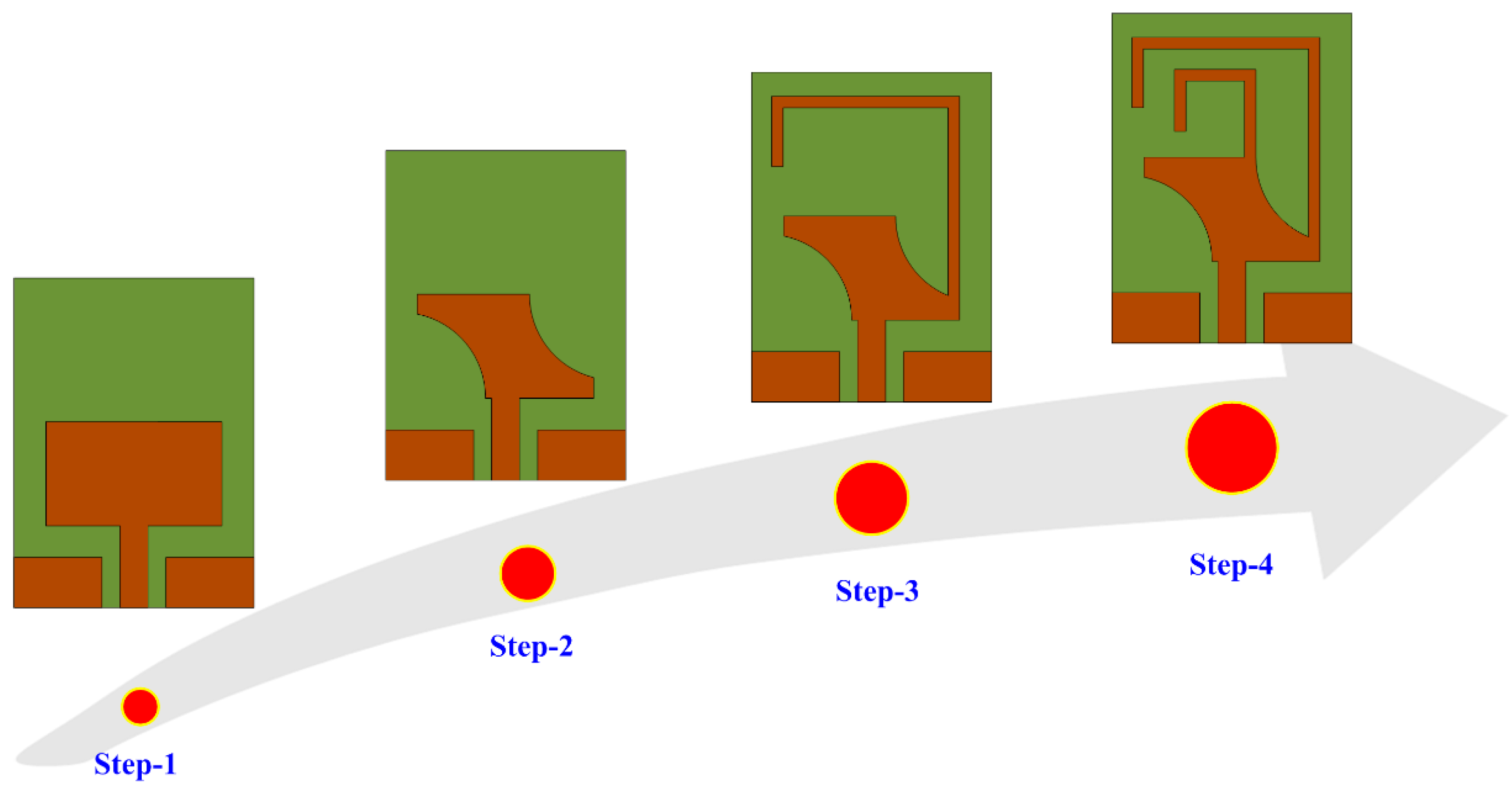

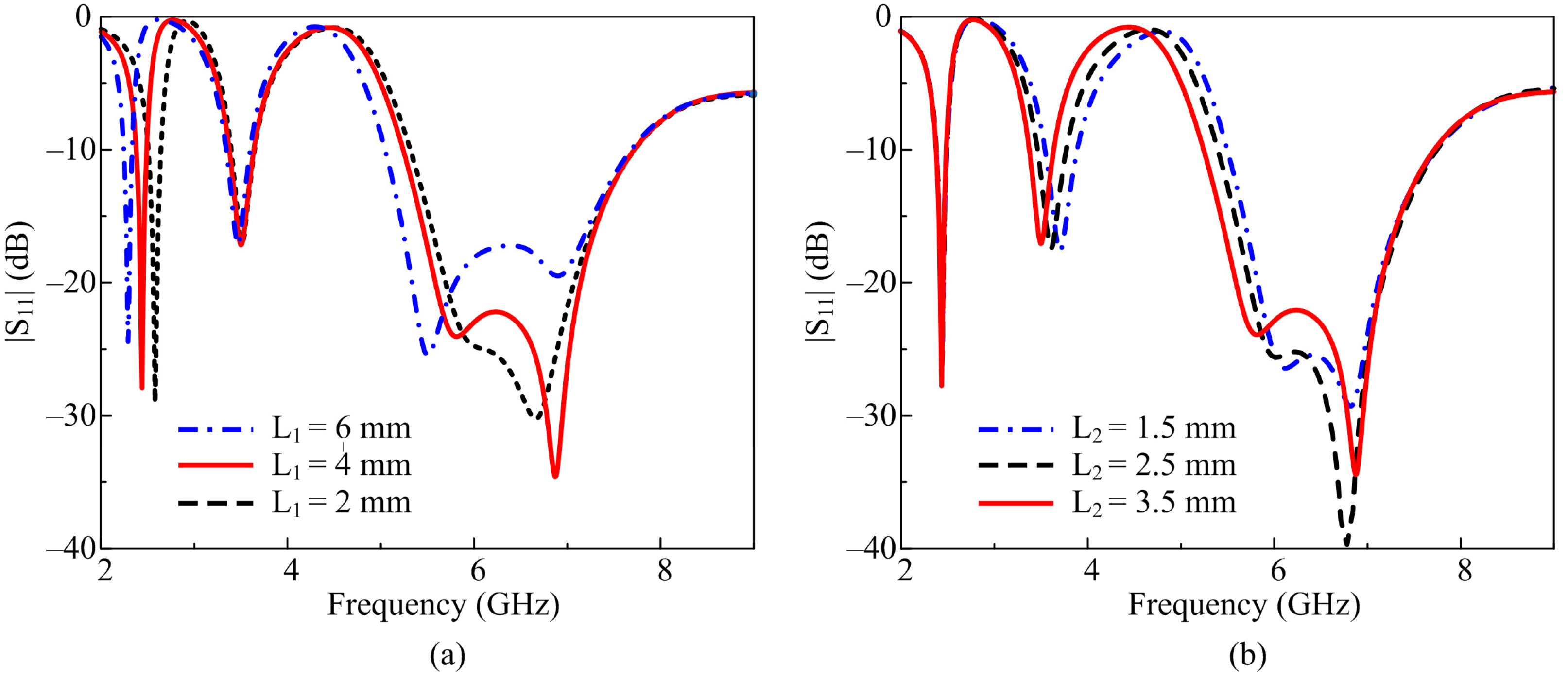
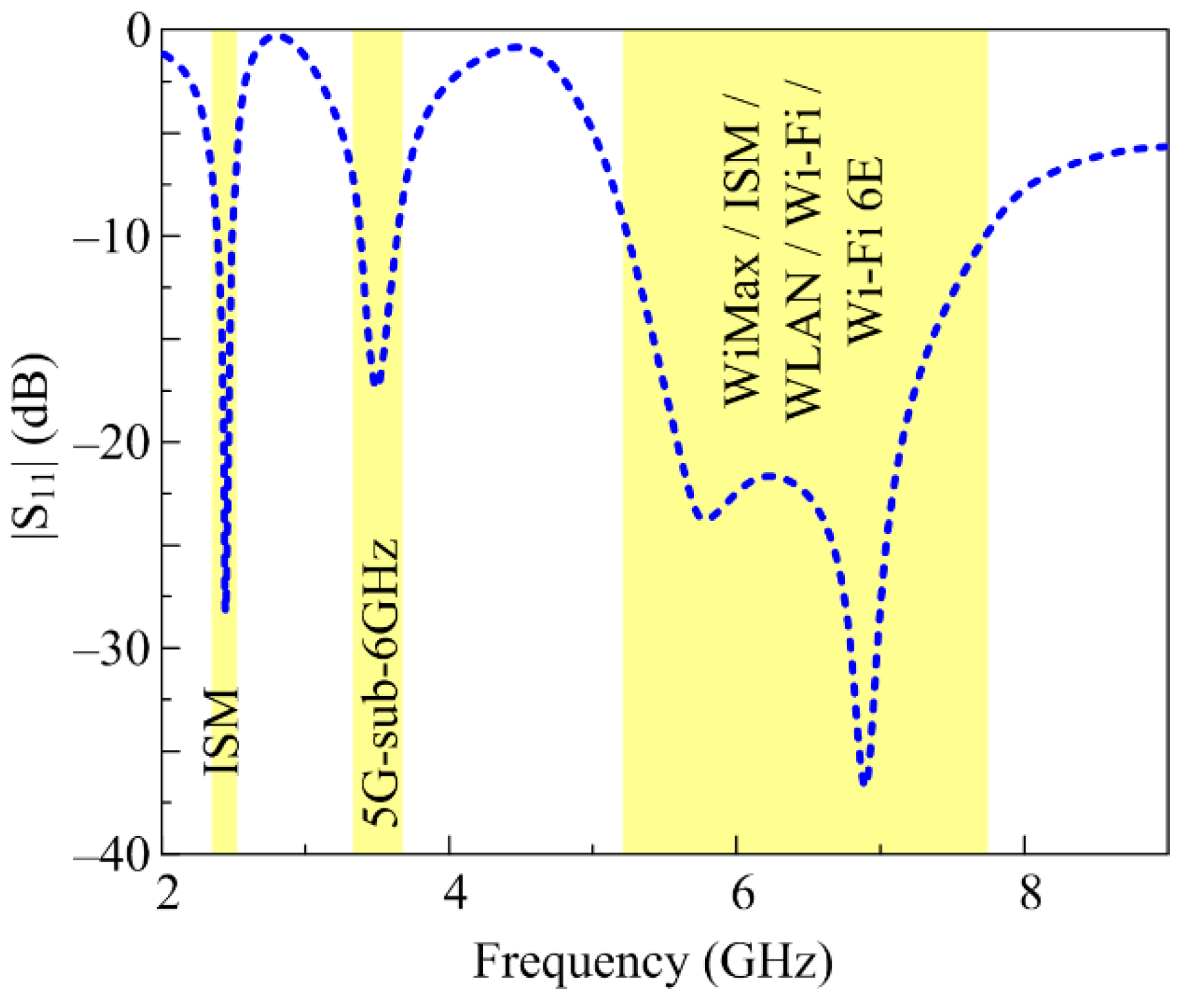

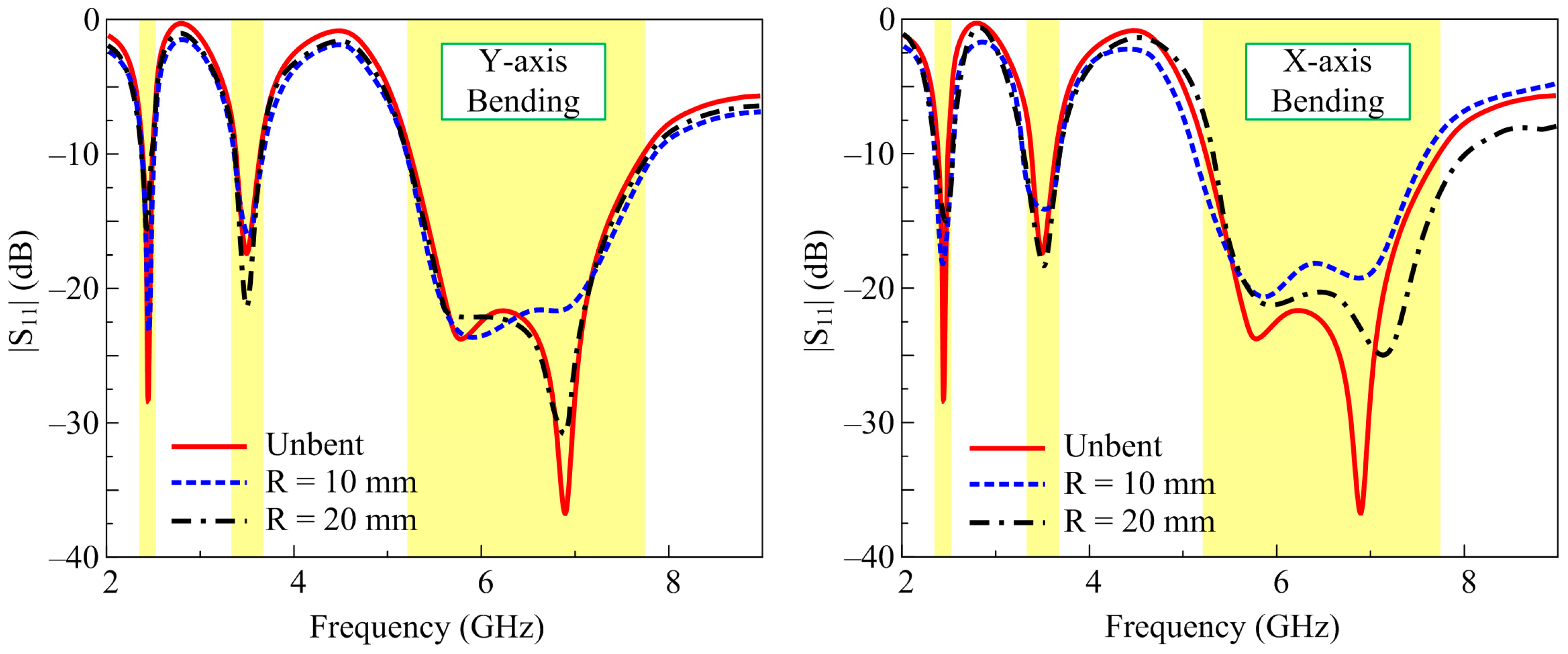

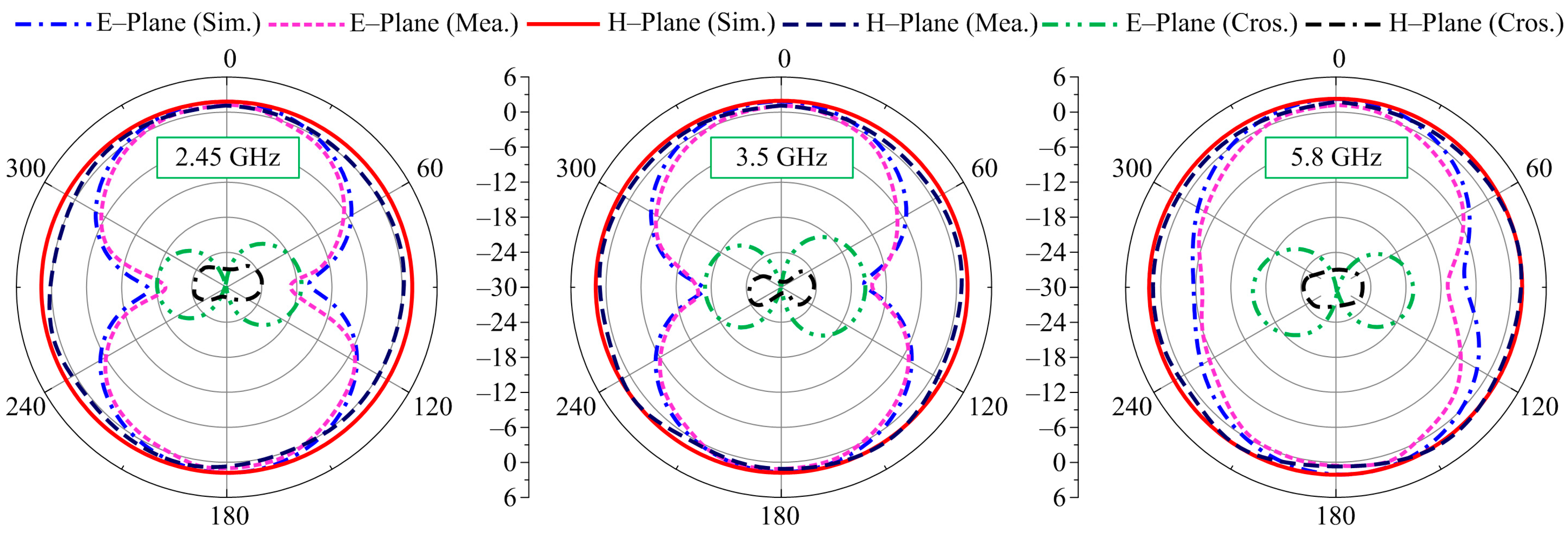

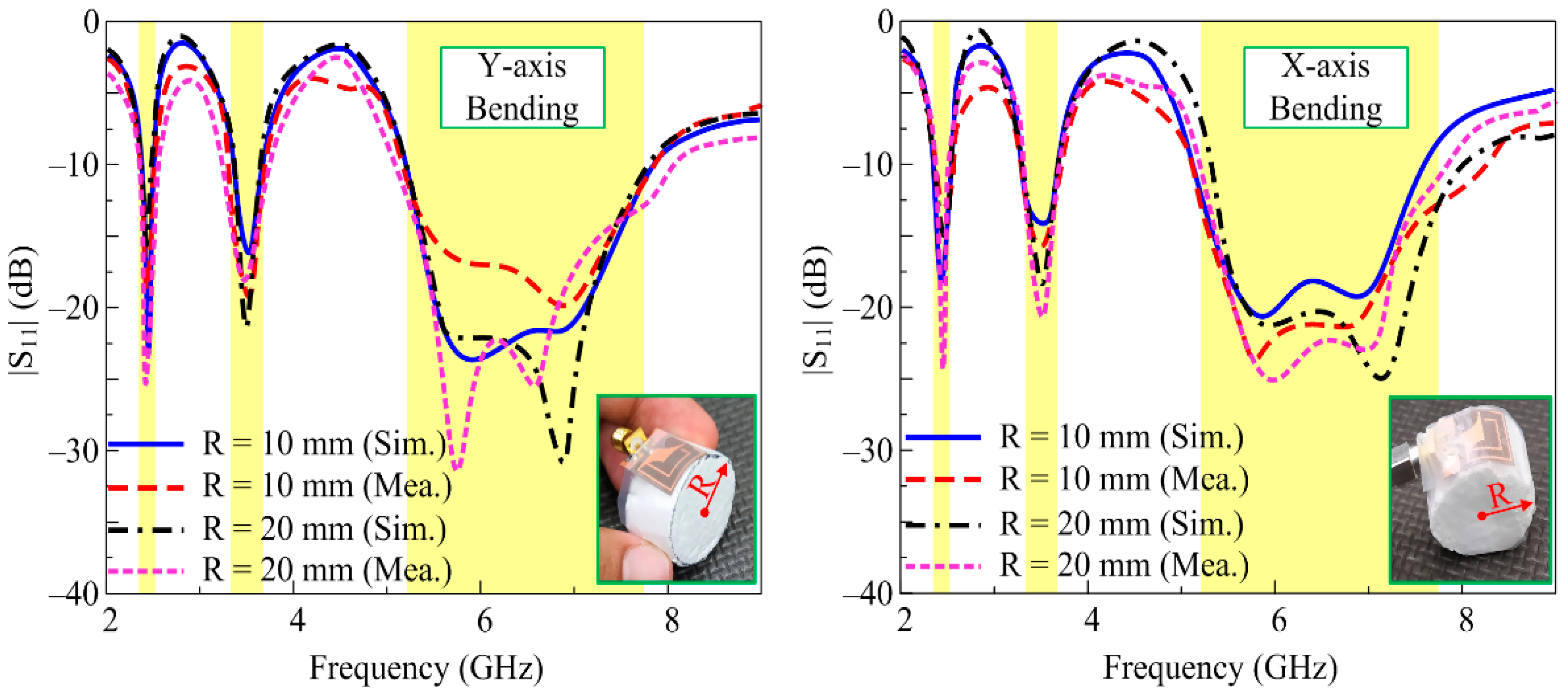

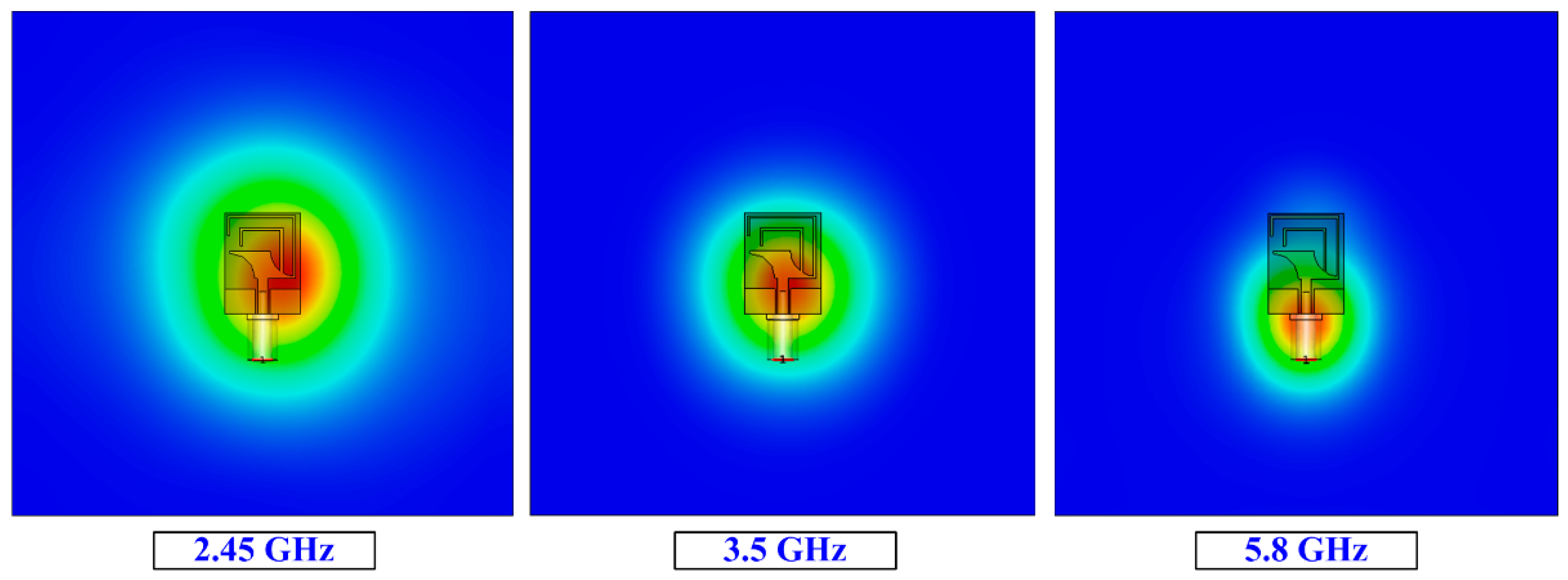
| Frequency | Skin | Fat | Muscle | Bone | SAR (W/Kg) 1 g | SAR (W/Kg) 10 g | ||||
|---|---|---|---|---|---|---|---|---|---|---|
| εr | σ | εr | σ | εr | σ | εr | σ | |||
| 2.45 | 38.06 | 1.44 | 5.28 | 0.1 | 52.79 | 1.7 | 11.41 | 0.38459 | 1.48 | 1.52 |
| 3.5 | 36.84 | 2.59 | 5.069 | 0.2 | 50.91 | 2.9 | 10.46 | 0.67 | 1.26 | 1.41 |
| 5.8 | 35.114 | 3.71 | 4.9549 | 0.2 | 48.485 | 4.96 | 9.6744 | 1.544 | 1.1 | 0.62 |
| Ref. | Physical Size (mm3) | Electrical Size (λ2) | No. of Bands | Design Technique | SAR (W/Kg) | Gain (dBi) |
|---|---|---|---|---|---|---|
| [10] | 45 × 45 × 2.4 | 0.37 × 0.37 | Single band | High-impedance-surface-enabled design | 0.0257 | 7.47 |
| [11] | 20.7 × 20.5 × 0.1 | 0.17 × 0.17 | Single band | EBG-FSS | 0.0182 | 7.9 |
| [15] | 122.5 × 122.5 × 1.8 | 1 × 4 | Single band | AMC | 0.371 | 7.2 |
| [16] | 70.4 × 76.14 × 3.11 | 0.57 × 0.62 | Dual band | Metamaterial-based complementary split-ring resonator | 0.381 | 3, 1.53 |
| [19] | 48.7 × 42.8 × 0.787 | 0.4 × 0.35 | Dual band | Metamaterial-based split-ring resonator | 1.79 | 2.7, 2.35 |
| [20] | 64.36 × 76.96 × 4.06 | 0.53 × 0.63 | Dual band | Aperture-coupled fractal | 1.24, 2.99 | 7.45, 4.75 |
| [21] | 28 × 32 × 0.394 | 0.23 × 0.26 | Triple band | Metamaterial array | Not provided | 2.5, 4.75 |
| [22] | 90 × 90 × 6 | 0.73 × 0.73 | Triple band | AMC array | 0.34 | 4.8, 5.1, 6.2 |
| [23] | 60 × 60 × 4.52 | 0.49 × 0.49 | Triple band | Two-layered substrates | 0.13, 0.09, 0.09 | 4.2, 6.6, 5.0 |
| This work | 15 × 20 × 0.254 | 0.12 × 0.16 | Triple band | Stub-loaded patch | 1.48, 1.26, 1.1 (1 g) 1.52, 1.41, 0.62 (10 g) | 1.08, 1.96, 2.99 |
Disclaimer/Publisher’s Note: The statements, opinions and data contained in all publications are solely those of the individual author(s) and contributor(s) and not of MDPI and/or the editor(s). MDPI and/or the editor(s) disclaim responsibility for any injury to people or property resulting from any ideas, methods, instructions or products referred to in the content. |
© 2023 by the authors. Licensee MDPI, Basel, Switzerland. This article is an open access article distributed under the terms and conditions of the Creative Commons Attribution (CC BY) license (https://creativecommons.org/licenses/by/4.0/).
Share and Cite
Awan, W.A.; Abbas, A.; Naqvi, S.I.; Elkamchouchi, D.H.; Aslam, M.; Hussain, N. A Conformal Tri-Band Antenna for Flexible Devices and Body-Centric Wireless Communications. Micromachines 2023, 14, 1842. https://doi.org/10.3390/mi14101842
Awan WA, Abbas A, Naqvi SI, Elkamchouchi DH, Aslam M, Hussain N. A Conformal Tri-Band Antenna for Flexible Devices and Body-Centric Wireless Communications. Micromachines. 2023; 14(10):1842. https://doi.org/10.3390/mi14101842
Chicago/Turabian StyleAwan, Wahaj Abbas, Anees Abbas, Syeda Iffat Naqvi, Dalia H. Elkamchouchi, Muhammad Aslam, and Niamat Hussain. 2023. "A Conformal Tri-Band Antenna for Flexible Devices and Body-Centric Wireless Communications" Micromachines 14, no. 10: 1842. https://doi.org/10.3390/mi14101842
APA StyleAwan, W. A., Abbas, A., Naqvi, S. I., Elkamchouchi, D. H., Aslam, M., & Hussain, N. (2023). A Conformal Tri-Band Antenna for Flexible Devices and Body-Centric Wireless Communications. Micromachines, 14(10), 1842. https://doi.org/10.3390/mi14101842










